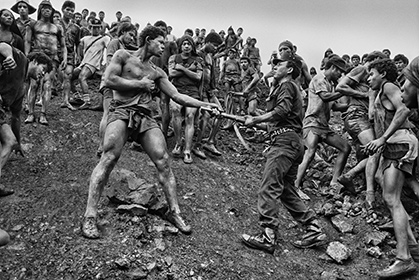By Andrea Lampros

Uganda, 2004
The images of world-renowned photographers Sebastião Salgado, Gilles Peress, Susan Meiselas, and others will be showcased in Envisioning Human Rights—a celebration of the 20th anniversary of the Human Rights Center. The exhibit opens at Berkeley Law on Thursday, August 28.
The public is invited to the opening reception with the curator and three of the photographers at 5:00 pm in the Steinhart Courtyard. The event kicks off the sale of photographs in advance of a silent, online auction.
From Salgado’s image of children witnessing Angola’s civil war to Meiselas’s photograph of Iraqi graves to Nic Dunlop’s portrait of Burmese leader Aung San Suu Kyi, the photographs tell a story of human rights challenges and triumphs over several decades.
“These photographs capture profound moments of courage and defiance,” said Eric Stover, faculty director of the Human Rights Center. “They remind us that human rights photography is at its best when it shuns the sensational and sentimental and instead finds human dignity in the face of injustice.”
In addition to Salgado, Peress and Meiselas, the ten featured photographers include Mimi Chakarova, Nic Dunlop, Stephen Ferry, Stephen Goldblatt, Ken Light, Thomas Morley, and Jean-Marie Simon. The artists donated 38 works to be shown and auctioned to benefit the Human Rights Center’s research on war crimes, sexual violence in conflict, and other violations of international law and human rights.
“Taking pictures has led me toward the recording and documentation of poor and marginalized communities, civilians caught up in war, refugees and torture,” said Thomas Morley, a London-based photographer who shares images of northern Ugandans who have survived atrocities that include the killing of their children and other loved ones. “For me, photography is tied up with the rights of people, recording their story and documenting their plight.”

Award-winning Magnum photographer Gilles Peress has spent more than four decades covering the ravages of war, from Latin America to Northern Ireland to Bosnia to Africa. “Badly used photography can be a vehicle for propaganda or emotional exploitation of the worst kind and runs the risk of desensitizing us,” he said. “Not shown at all…you enter into the black hole of not seeing and therefore a void of consciousness. Which do you choose?”
The exhibit features photos from Bosnia, Guatemala, Bolivia, Brazil, Angola, Uganda, Tanzania, Burma, Vietnam, Moldova, Iraq, and the United States. Acclaimed cinematographer Stephen Goldblatt, Director of Photography for the recently released feature film Get On Up about James Brown, shares his photographs of Burma.
The exhibit is adjacent to a selection of four paintings from the Abu Ghraib series by artist Fernando Botero that he donated to the Berkeley Art Museum in 2007. The renowned Colombian painter donated 47 paintings to the museum in recognition of Berkeley’s historic role in the human rights arena.
Envisioning Human Rights, curated by artist-curator Pamela Blotner, will be on display outside of the law school’s main library reading room through October 2014. All images and photographer bios can be viewed online at envisioninghumanrights.com.